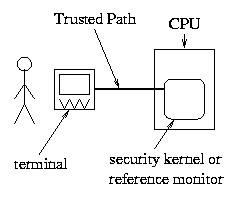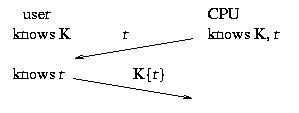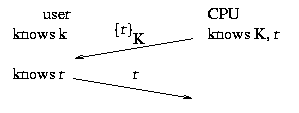Authentication - Trusted Paths and Smart Cards
Lecturer: Professor Fred B. Schneider
Lecture notes by
Borislav Deianov
Last time we discussed the problem of
authenticating people.
We decided that we must exploit their
strengths and not be foiled by their weaknesses. We talked about the use
of secrets (in the form of passwords), i.e "something you know".
Suppose we have taken the necessary measures and an
attacker cannot guess a password. What can the attacker do beyond
guessing? The obvious gambit is theft.
Consider the following scenario: a user is presented with a login
window and asked for a password. The user enters the password. But
this window is a fake, being run by a program that emails the typed
password to an attacker. The defense:
confidence that the login window
being displayed (apparently)
by the operating system is not, in reality, from a malicious program.
And one implementation of this defense is to build a
trusted path---an authenticated, secrecy- and
integrity-protected channel between the reference monitor (or security kernel)
and the user.
 To build a trusted path,
we identify a key on the keyboard (in Windows NT this is the key
combination Ctrl-Alt-Delete) and make it special. Whenever this key is
pressed, the security kernel gets control and monitors what is typed
on the keyboard.
There is no way to hijack
the key that opens the trusted path.
To build a trusted path,
we identify a key on the keyboard (in Windows NT this is the key
combination Ctrl-Alt-Delete) and make it special. Whenever this key is
pressed, the security kernel gets control and monitors what is typed
on the keyboard.
There is no way to hijack
the key that opens the trusted path.
Note, we do need to make some assumptions about the system. We
know that Ctrl-Alt-Delete invokes the Windows-NT security kernel,
but how can we be certain that Windows NT is running?
Rebooting the computer would ensure that---provided Windows-NT is properly
installed.
And how do we know that Windows-NT is
installed on the hard drive?
This is a physical security question.
In general, we strive to reduce computer security questions to
tractible physical security questions, for without a modicum of
physical security very little is possible.
Authentication based on "something you have"
In today's computing systems,
authentication is based almost exclusively on "something you
know". Authentication based on "something you have" will
become increasingly prevelant in the near-term future.
The "something you have"
refers to a physical device that a person carries and
uses for authentication. Such devices are subject to theft,
so they should only be used together with some other authentication
mechanism
(e.g. a PIN). Examples of something you might have
include physical keys and credit cards. Notice that these
require a special hardware "reader" for communicating with a computer.
A more sophisticated example of "something you have"
is the smart card. There are several
types of smart cards in use today:
- PIN-protected memory cards. Information stored in the memory of
such a card can be read only after a PIN has been typed into the card.
- Cryptographic challenge/response cards. These cards have on-board memory
and processors. Thus, they can store keys as well as performing encryption
and decryption.
Here are two ways that a cryptographic challenge/response card might
be used for authentication.

Shared key scheme: both the user and the CPU need to know a shared secret
key K. There is a separate key for each user.
The CPU sends a number r to the user (the
"challenge"). The user (i.e. the smart card) encrypts r with
K and sends the result (the "response") back to the CPU. The
CPU also independently
encrypts r with K and compares that result
with the response provided by the user.
If the two match, then whoever generated the response "knows" the
shared secret and, therefore, is presumed to be the user (since nobody
else posseses secret key K).

Public key scheme: The user picks a private key k and
tells the CPU the corresponding public key K. The CPU chooses a
number r (the "challenge"),
encrypts it with K, and then sends that to the
user. The user decrypts the challenge with k and sends the
result (the "response") back to the CPU. The CPU is able to compare the number
r it chose for the challenge
with the response received from the user.
If the two match, then whowever generated the response "knows" the
private key and, therefore, is presumed to be the user (since nobody
else posseses private key k).
Note on notation: {r}K means r encrypted
with a public key K,
K{r} means r encrypted with a shared key K.
A third "something" that you might have is:
- Cryptographic calculator. This is similar to a
challenge/response card but requires no special reader; instead it
has a small keyboard and display. The computer furnishes
a challenge, the user types that challenge
into the card, the calculator displays a response, and then
the user types that response into the computer.
A variant, which saves user typing, has
a clock in the card. Here, the calculator periodically displays the
encrypted time, the user types that encrypted time into to the computer.
Thus, this is a challenge/response protocol where the challenge is
never sent explicitly, but rather is understood by both parties to
be the current time.
Obviously, this scheme only works if the clocks are approximately synchronized
and if an attacker cannot reset the clock on the computing system.
One final protocol for such a device
was devised by Leslie Lamport and is sometimes called
Lamport's hash or Lamport's password scheme.
In what follows, h is assumed to be
a cryptographic hash function (see
Lecture 10); n and m are
natural numbers (initially, n = m = 1000, or so).
The scheme works as follows:
| user | | CPU
|
|---|
user stores:
uid,password
| | server stores:
uid,n,m,H = hm(password)
|
| 
|
| | n := n-1
|
| 
|
user computes:
hn(password)
|
| 
|
| |
if hm-n(s) = H
then m := n; H := s; accept
else reject
|
 To build a trusted path,
we identify a key on the keyboard (in Windows NT this is the key
combination Ctrl-Alt-Delete) and make it special. Whenever this key is
pressed, the security kernel gets control and monitors what is typed
on the keyboard.
There is no way to hijack
the key that opens the trusted path.
To build a trusted path,
we identify a key on the keyboard (in Windows NT this is the key
combination Ctrl-Alt-Delete) and make it special. Whenever this key is
pressed, the security kernel gets control and monitors what is typed
on the keyboard.
There is no way to hijack
the key that opens the trusted path.


